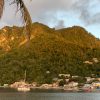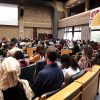Monday, May 13, 2024
News and Views from the Global South
NAMIBIA: Tens of Thousands Displaced by Flooding
Moses Magadza interviews SIMON NHONGO, UN Resident Coordinator for Namibia
- Namibia is experiencing flooding on a scale last seen nearly 50 years ago. The northern parts of the country are the worst hit.

U.N. team assessing the needs of an estimated 54,000 people displaced by floods in Namibia. Credit: UNDAC team
Simon Nhongo, the United Nations Resident Coordinator for Namibia visited the worst-affected parts during the first week of April.
IPS: You have just returned from a survey of affected areas. What did you find? Simon Nhongo: Overall, it’s amazing that so many people could be displaced – approximately 54,000. We are not talking about those who were affected, who number over 350,000 in the north-central [region] as well as the north-east (Kavango and Caprivi). The displaced either lodge with friends or move into relocation camps and about 16,000 people have moved into such facilities. They are in a very desperate state, with no clue what will happen to them.
Added to this is disruption in the education sector, where pupils are not attending schools. In camps that have tents, some displaced teachers are offering classes. It is pathetic the way people have to cope.
IPS: It has been reported in local media that in some areas the flooding has been so severe that it has reduced the distance between people and predators. What did you see? SN: Not that we saw anything dramatic like crocodile or hippo attacks as such but, indeed, out of the reported 100 people who lost their lives country-wide, there are cases of people who were killed by crocodiles or by hippos.
Most deaths resulted from drowning when people underestimated the currents’ flow along river channels. However, one small positive aspect is that in many areas – particularly in the North – some fish has been washed up from Angola; so, there is a lot of fish being sold on road sides, which provides protein but this is a small consolation, given the scale of the crisis.
IPS: Has the country been caught unawares? SN: The country was obviously caught unawares. This is a unique situation last seen nearly 50 years ago. Anticipating it would not be easy.
The government is making efforts to devise means of coping with such crises on a long-term basis. Thus, the Prime Minister (Nahas Angula) has presented to Parliament, a national contingency planning machinery, which would constitute a long-term instrument for the country to avoid being caught unawares.
IPS: Would this involve resettling people? SN: It would, especially those who are already settled in places they should not be, such as low-lying areas susceptible to flooding even under normal circumstances. It will also involve some extensive land-use analysis, planning and storm-water drainage. These are programmes in which the U.N. is helping the Government. We are indeed looking at developing long-term sustainable means of coping with humanitarian crises like this.
IPS: President Hifikepunye Pohamba has declared some affected areas disaster areas. How important was this? SN: This was extremely important and I am sure it was instrumental in mobilising the resources as quickly as they are being raised. If the government had not declared the emergency, it would not have brought out the magnitude of the disaster. More lives could have been lost. The declaration helped mobilise international opinion and resources – thus relieving suffering and saving lives .
IPS: How would you characterise the enthusiasm with which this flash appeal has been met by potential contributors since it was launched? SN: Well, the response has been quite good. Already we have received $350,000 from the U.S. and $317,000 from the Germans. Significantly, we have managed to mobilise about $1.3 million from our own United Nations Central Emergency Response Fund; even a small neighbouring country like Botswana has already contributed over $60 000 in the form of tents, food and other supplies.
IPS: Responding to an emergency like this one calls for not just money, but personnel and equipment like helicopters, boats and so on. From your assessment, how is Namibia faring in this regard? SN: Under normal circumstances, Namibia could have managed with the resources available within the country, but the scale of the problem is so huge that Namibia needs some external assistance. It is gratifying that, for our assessment mission, we were flown using the government’s own resources, which is most commendable. These were regular resources at their disposal but when a country gets into a major humanitarian crisis, the country needs external help.
That’s why the U.N. Office for the Coordination of Humanitarian Affairs, through its regional office in southern Africa, managed to field some personnel to come and help us assist the government in these efforts. We had a team of between five and 10 UN Staff from the U.N. Disaster Assessment and Coordination Team helping the Government to refine the assessments in affected areas.
IPS: What other interventions have been recommended? SN: People in the Caprivi have been cut off by the floods from their usual sources of socio-economic services like hospitals and schools so we have recommended boats. Other basic needs are tents. We visited a number of camps where most of the men were sleeping outside to make way in the tents for children and women. Food is yet another problem. Mosquito nets too, because in a flooded environment like this, mosquitoes breed freely and transmit malaria. Malaria cases have been gradually rising over the past few weeks.
Mobilising all these requirements in good time is the major challenge.
IPS: Namibia is just one of several countries facing flood-related problems. Angola is another example. This seems to be a perennial regional problem. Do you think it is about time the region developed a regional response to floods? SN: You are very correct. The effects of flooding could be localised in the individual countries but with closer collaboration among regional countries through harnessing and trans-boundary water management, the burden could be eased.
IPS: Are there areas that are still inaccessible? Do you envisage the numbers of displaced people growing as you gain access? SN: There are areas that cannot be accessed. Fortunately, latest reports predict reduction of water levels along the major rivers. However, that could be deceptive because river levels are going down as the water percolates into the flood plains, thus affecting more people.
Most predictions indicate – barring a major storm – that the numbers of affected and displaced people will stabilise. The fact remains, however, that the damage has already been done and people are yet to suffer for a long time. The problem will get bigger as people’s recovery needs become more apparent. There are roads and bridges that have been swept away.
The US $2.7 million we have asked for is miniscule. The damage done will run into billions of Namibian dollars and the government will need to look further afield to better-endowed development partners like bilateral, the EU and the World Bank.

 Print
Print



